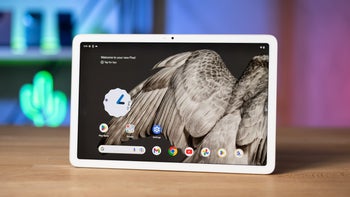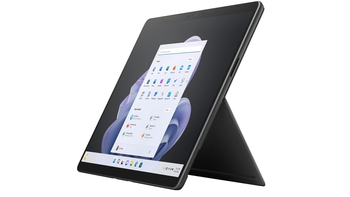Asus Padfone Hands-on Review

The concept is very interesting and unique – a phone that can be docked into a larger tablet-like frame. The dock only acts as a larger screen and battery life extender. All the computing and connectivity comes from the phone. The configuration has its up and down sides. On the plus side – having one phone and one dock will be relatively cheaper compared to buying separate devices (hopefully). We though the weight will also be lesser compared to having two separated devices, but it is not – the phone weights 129 grams and the station is another 724 grams.
The drawbacks are several. One is the lack of options – you can only go with 4.3” on the phone and 10.1” for the frame. If you like 7” tablet, you cannot get it. Also, if you decide that you need to upgrade your phone, you’ll have to get either a new tablet or get another Padfone version which has smaller size dock (if one becomes available). A very important one is that in order to use your tablet, you need to have the phone in close proximity and insert it into your tablet. If you need the phone again, you either have to take it out, or use a Bluetooth headset to carry the call.
Now let’s take a look at the actual hardware. The whole Padfone system is comprised of 4 separate devices. The actual Padfone which is a 4.3” Android 4.0 power phone, the Padfone Station - tablet frame featuring 10.1” display, the Station Dock - keyboard docking station where the tablet frame attaches to, and a stylus, which also acts as a wireless Bluetooth headset.
The Padfone construction is exceptional – very sturdy, metal feel leaves you wishing all gadgets were built like this. The weight is very manageable at 129 grams.
The display is the standard for higher-end phones these days – a Super AMOLED 4.3” with 960x540 resolution, resulting in about average 256 ppi. Colors and brightness seems what you could expect from such display – vibrant and deep blacks.
The processing is entrusted to the new Qualcomm Snapdragon S4 with 1.5GHz Cortex A15 dual-core CPUs and Adreno 225 GPU – the same SoC found in the HTC One S, for example. The processing power provided is more than sufficient, resulting is very eye-pleasing and smooth UI operation.
There will be three variants, depending on the amount of flash memory available – 16, 32 or 64GB. The rest is pretty much standard for a high-end Android phone – 8 megapixels rear camera, Bluetooth 4.0, VGA front camera, microSD memory expansion slot.
The second module in the system is the Padfone Station – pretty much a tablet like frame with a 10.1” screen and 6600 mAh battery. Open the hinged lid in the back, slide the Padfone in and you have a working tablet! Of course in order to make space for the phone, the lid and the area around it is slightly raised, but nothing that can ruin the experience of using it. Because there were only a few unlatched Padfones available (really hate how most companies organize their events and not think about all the journalists/bloggers that will have to cover their devices), but we could experience a few inserts in and out of the Station. Overall – easy process but still some people will surely find this added action inconvenient.
The Padfone Station construction is also super – just like the Padfone. What is somewhat confusing is the weight – a whopping 729 grams. For comparison, iPad 2 is 613g, and Samsung Galaxy Tab 10.1 is 595!
The screen is 10.1” with 1280x800 resolution. The colors and brightness seem OK, but what made a bad impression are the extreme reflections! We could not image what would happen if you take it outside – it seems like it won’t be usable.
In order to use the keyboard accessory, one will have to dock the phone to the Padfone Station, and then attach the station to the keyboard. In this configuration it pretty much resembles a laptop (or the Asus Transformer Prime). The construction is again superb. The keys are well-spaced with great tactile feel. USB ports and SD slot are placed on the sides.
The last piece of the puzzle is the stylus, which also doubles as a Bluetooth headset. Something to note – in order to use it, you have to hold the pen next to the ear for the duration of the call. There is no ear clip or anything else.
Final thoughts:
The Padfone is definitely something to look for and try when it is released in April. While it will definitely find warm welcome by some people, we feel that it will not become a mass product. Even though very well executed, the whole notion of having to insert your phone into your tablet every time you want to use a tablet does not seem very trilling. From our personal experience, most of the time when we are at home, we do not carry the phone and the tablet all the time. So the phone might be in one room and the tablet in the other. In such scenarios, the Padfone will not be the perfect solution. Of course, there will be other times where having a 4-in-1 will be just perfect!
Asus Padfone video demonstration:
Asus Padfone video hands-on:
The Padfone construction is exceptional – very sturdy, metal feel leaves you wishing all gadgets were built like this. The weight is very manageable at 129 grams.
The display is the standard for higher-end phones these days – a Super AMOLED 4.3” with 960x540 resolution, resulting in about average 256 ppi. Colors and brightness seems what you could expect from such display – vibrant and deep blacks.
The processing is entrusted to the new Qualcomm Snapdragon S4 with 1.5GHz Cortex A15 dual-core CPUs and Adreno 225 GPU – the same SoC found in the HTC One S, for example. The processing power provided is more than sufficient, resulting is very eye-pleasing and smooth UI operation.
The second module in the system is the Padfone Station – pretty much a tablet like frame with a 10.1” screen and 6600 mAh battery. Open the hinged lid in the back, slide the Padfone in and you have a working tablet! Of course in order to make space for the phone, the lid and the area around it is slightly raised, but nothing that can ruin the experience of using it. Because there were only a few unlatched Padfones available (really hate how most companies organize their events and not think about all the journalists/bloggers that will have to cover their devices), but we could experience a few inserts in and out of the Station. Overall – easy process but still some people will surely find this added action inconvenient.
The Padfone Station construction is also super – just like the Padfone. What is somewhat confusing is the weight – a whopping 729 grams. For comparison, iPad 2 is 613g, and Samsung Galaxy Tab 10.1 is 595!
The screen is 10.1” with 1280x800 resolution. The colors and brightness seem OK, but what made a bad impression are the extreme reflections! We could not image what would happen if you take it outside – it seems like it won’t be usable.
The last piece of the puzzle is the stylus, which also doubles as a Bluetooth headset. Something to note – in order to use it, you have to hold the pen next to the ear for the duration of the call. There is no ear clip or anything else.
Final thoughts:
The Padfone is definitely something to look for and try when it is released in April. While it will definitely find warm welcome by some people, we feel that it will not become a mass product. Even though very well executed, the whole notion of having to insert your phone into your tablet every time you want to use a tablet does not seem very trilling. From our personal experience, most of the time when we are at home, we do not carry the phone and the tablet all the time. So the phone might be in one room and the tablet in the other. In such scenarios, the Padfone will not be the perfect solution. Of course, there will be other times where having a 4-in-1 will be just perfect!
Asus Padfone video hands-on:












Things that are NOT allowed: